Mercury’s Perihelion Advance
In 1846, famed astronomer Urbain Le Verrier embarked on a study of the
planets in the outer solar system. Uranus was the farthest
known at the time and careful observation revealed its motion did not
agree with the known gravitational influences of the other planets.
This led to the prediction and later discovery of Neptune.
Buoyed by this success, he turned his attention to the inner solar
system and to a study of Mercury he’d started some years
earlier. Mercury was noted to have a strong elliptical orbit;
at least in comparison to other planets. It had also been
noted that its orbit rotated as a whole, such that its closest point to
the Sun – the ‘perihelion’ – was seen to steadily advance
over a period of years. The reason for this was assumed to be
that the outer planets’ gravity was pulling Mercury’s orbit around.
Le Verrier also assumed this but could not be sure if it were the
entire reason. By undertaking an onerous effort of detailed
hand-calculations he determined that the outer planets should cause
Mercury’s perihelion to advance by 527 arcseconds per
century. As part of the same exercise he determined its
actual advance, based on observations spanning a century and a half,
was 565 arcseconds/century. This left a discrepancy of 38
arcs/century that could not be accounted for by Newtonian gravity.
A hunt then ensued to find out from where this 38 discrepancy might
arise. At first it was thought there might be an additional
planet within Mercury’s orbit that was responsible.
Tentatively named ‘Vulcan’, this planet was searched for but never
found. Thereafter various modifications to Newtonian gravity
were proposed to accommodate the discrepancy.
Using better observational data and improved calculations, the 38
discrepancy has since been revised to 43 arcs/century and the accepted
explanation for it is that it is fully due to the predictions of
General Relativity. Wikipedia offers this table as a summary
[1]:
| Amount (arcsec/century) |
Cause |
| 531.63 ±0.69 |
Gravitational tugs of the other planets |
| 0.0254 |
Oblateness of the Sun |
| 42.98 ±0.04 |
General relativity |
| 574.64 ±0.69 |
Total |
| 574.10 ±0.65 |
Observed |
|
Table 1: sources of the precession of perihelion for Mercury |
There are two numbers of importance here. One is the
predicted amount advance due to Newtonian gravity, which is
532 arcs/cent. The other is the observed amount of advance,
which is 575 arcs/cent. Now for something more important: if
either of those numbers were wrong by a significant amount then the
difference between them, 43, would also be wrong. Unless that
is, both numbers were wrong by the same amount and in the same
direction.
Without access to the proper equipment it won’t be easy to
challenge/analyse the observed 575 number. But it will be
possible to analyse the calculated 532 number, and that will be the
focus of what follows.
The Ring-Planet Model
Le Verrier’s original analysis can be found here (in French)
[2]. Since then a number of researchers have improved on his
result using better observational data and calculation
techniques. They include: Le Verrier (repeat,1859),
Newcomb (1895), Doolittle (1912), and Clemence (1947).
G. M. Celmence’s [3]
is the ‘modern result’ quoted by Wikipedia in the above Table 1
(excluding his oblateness calc.). Here is a comparison of
their results:
| Planet |
Le Verrier |
Newcomb |
Doolittle |
Clemence |
| Venus |
276.312 |
277.649 |
276.188 |
277.881 |
| Earth |
90.747 |
91.433 |
90.700 |
90.038 |
| Mars |
2.471 |
2.485 |
2.472 |
2.536 |
| Jupiter |
152.900 |
154.004 |
152.904 |
153.584 |
| Saturn |
7.266 |
7.310 |
7.260 |
7.302 |
| Uranus |
0.141 |
0.141 |
0.141 |
0.141 |
| Neptune |
0.044 |
0.044 |
0.042 |
0.042 |
| Total |
529.881 |
533.066 |
529.707 |
531.524 |
|
Table 2: comparison of researcher’s results |
An aspect these all have in common is that they model surrounding
planets as though they were rings of uniform linear mass.
That is, they treat each planet as though its mass were evenly
stretched along its orbit. This diagram shows the idea:
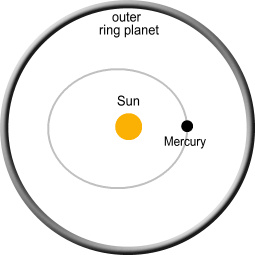
By doing this we can determine each ring-planet applies a net force on
Mercury in a direction opposite the Sun and that this force will cause
Mercury’s orbit to steadily rotate. We can also calculate the
contribution from each ring and sum them to get a total.
This reference [5] gives the basic method. Equations (12) and
(15) tell how to calculate the force and angular advance from a single
planet. By doing this for the planets we produce the
following table (see the Mathematica notebook for the script that
generated this table):
| Planet |
arcs/cent |
| Venus |
268.871 |
| Earth |
93.532 |
| Mars |
2.387 |
| Jupiter |
160.093 |
| Saturn |
7.733 |
| Uranus |
0.145 |
| Neptune |
0.044 |
| Total |
532.805 |
|
Table 3: simple ring-model calculation |
This table differs from Table 2 because we are modelling the planets as
circles rather than ellipses and not adjusting for orbital
elevations. Still, it is very close, and this confirms that
similar approximation methods were used by the people in Table 2.
Using Computer Simulations
Is this ring-planet method a valid model? No doubt it is a
convenient one because we only look at a planet’s average position and
don’t have to worry about how an outer planet moves or that fact that
gravity from a point source is different from a line source.
But convenience is no substitute for or guarantee of
correctness. A big problem that faces us is that modelling
the influence from a planet’s actual position is going to be much
harder to do – a ring-planet is difficult enough to model as it is.
No doubt some of the individuals listed above considered this problem
but had no choice than to stay with the simplifications.
Luckily we in the modern age have a work-around: computer
simulation. By requesting a computer to consider the
force/acceleration/ velocity/position situation at a point in time it
can calculate an updated velocity/position at a small later point in
time and repeat the process over and over. No matter how
complicated the forces involved, the computer simply chews through them
and spits out accurate results.
So that is what we’ll be doing here. Starting with simple
situations to prove the concepts and then applying them to real
data. These simulations will be done using the software
Mathematica. For those who have access they can follow the
steps and diagrams in this notebook:
download Mathematica notebook
We’ll begin by considering a hypothetical solar system involving a
‘sun’, ‘mercury’, and ‘venus’ – spelt here in lower-case to distinguish
them from the real bodies.
We’ll give this sun a mass of 50 units, mercury a mass of 1/100th
units, and venus a mass of 2 units. Set the gravitational
constant to G=1. The sun will remain fixed at position
(x,y)=(0,0), mercury will start at (1,0) and venus at (7,0).
mercury will have an eccentricity of 0.4 and venus will move in a
perfectly circular orbit, i.e. with an eccentricity of zero.
This diagram shows how both planets would move if neither influenced
the other:
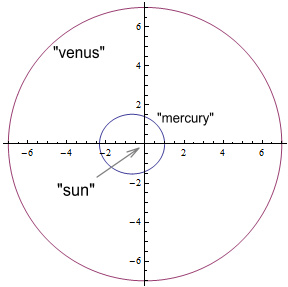
Now allow mercury to be gravitationally influenced by venus, but the
sun’s location and venus’ orbit will remain unchanged. This
is the result after 200 seconds:

(click to enlarge)
We now see mercury’s orbit wobbling and being dragged forward by
venus. If we allow the simulation to continue, this
is how mercury’s orbit would look during selected periods:

(click to enlarge)
It appears to take 5050 seconds for the ellipse to fully
rotate. That corresponds to 360/5050 = 0.071 degrees per
second, or 4.28 degrees per minute.
Instead of displaying the results this way we could instead just plot
the angle of perihelion point as a function of time. Doing
this over a 10 minute period shows:

Here we see the perihelion point oscillate back and forth somewhat but
overall it moved forward about 42 degrees. A line-of-best-fit
to this graph reveals a gradient of 4.28 degrees per minute, which
agrees with the above.
Now redo the simulation. Everything will be kept the same
except that venus will orbit with exactly double the
velocity. This is what a chart of the perihelion angle shows:
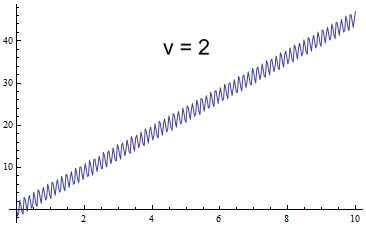
As might be expected, the oscillations have double the frequency
because venus is passing mercury twice as often. They are
also of lower magnitude. But the more interesting point is
that the slope is steeper, reaching 44 degrees. The actual
slope is 4.53 degrees per minute. So increasing the velocity
increased the perihelion advance.
Now redo it with venus moving at half the original speed:

The oscillations are slower and broader and the slope is reduced to
3.86 deg/min. By slowing the velocity we have reduced the
amount of perihelion advance.
The next result is even more interesting. We will reduce the
speed to one tenth (1/10th) of the original:
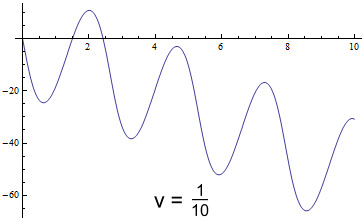
The perihelion is no longer advancing but receding! The slope
on this is minus 5.20 deg/min. Further experimenting shows
that making the velocity 0.155 times the original yields a flat slope,
with mercury wobbling but making no overall progress.
As a final example we’ll make venus orbit in the opposite direction
with the exact negative of the original velocity:

Rather than push the perihelion backward, it is causing it advance
faster, with a slope of 5.01 deg/min. Some might object to
this example because outer planets don’t orbit backward. But
according to ring-planet model it should make no difference what the
direction was.
What the above reveals is that the ring-planet model is not a valid
method of calculating perihelion advance and that we must also take
into account the speed of the orbiting planets. It was not
easy for people living decades ago to know this. But with modern
computers, anyone can confirm it easily.
Having done this, we will now apply the above method to real
data. Doing this for each of the outer planets from Venus to
Neptune over a hundred year period (or more for the outer planets)
yields the following charts:
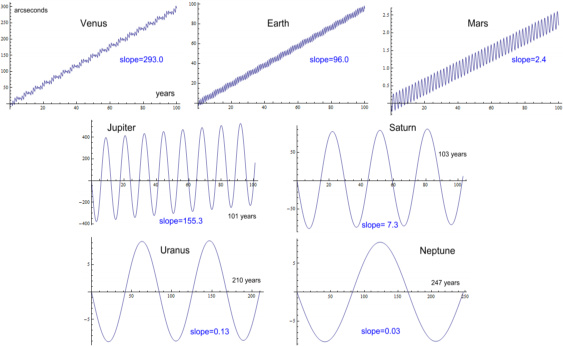
(click to enlarge)
This gives the following table:
| Planet |
arcs/cent |
| Venus |
293.0 |
| Earth |
96.0 |
| Mars |
2.4 |
| Jupiter |
155.3 |
| Saturn |
7.2 |
| Uranus |
0.13 |
| Neptune |
0.03 |
| Total |
554.1 |
|
Table 4: contributions from a fixed Sun |
Comparing this with Table 2 shows the results to be similar for most
planets. Venus and Earth give a notably higher contribution of
an additional 15 and 6 arcs respectively.
The overall total is 554 arcs/cent. This is very different from
the ‘official’ total of 532 arcs/cent. But we are far from done
because there are many other aspects to consider.
Contributions from Multiple Planets
Another assumption made by the ring-planet model is that it is
acceptable to calculate the contributions from surrounding planets
individually and then total them. This might seem reasonable
because Newtonian gravity is additive, so presumably perihelion
advances should likewise add.
To find out if they do, we will add a second orbiting planet to our
hypothetical system. Call this ‘jupiter’, give it a mass of 4
units and start it at (14,0), i.e. at double the venus
distance. Its orbit will be perfectly circular and its
velocity will be smaller than venus’ by the square-root of 2 (since
that’s what orbital mechanics requires). Removing venus from
the system, and plotting jupiter’s contribution on mercury’s perihelion
shows the following:

The slope of this is 0.65 deg/min.
Now redo the simulation with both venus and jupiter acting on mercury
simultaneously. Here’s the result:
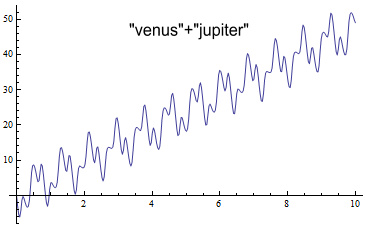
The wobbles in the perihelion angle have become rather complicated
because it contains a high-frequency contribution from venus and a
low-frequency from jupiter. The average slope of this is 4.78
deg/min.
Recall that venus on its own causes a slope of 4.28 and jupiter causes
0.65. Adding 4.28+0.65 gives 4.93. This is greater
than the 4.78 contribution from both planets when acting together.
What this shows is that we can’t simply add contributions from
individual planets and expect a sensible total. Instead we
must consider the planetary effects all at the same time.
Doing this algebraically on paper will be next to
impossible. But with computers… no problem at all.
So now to try this with real data. Rather than doing all the
planets at once, we’ll start with Jupiter and Saturn since they have
the largest combined influence. Doing so gives this chart:
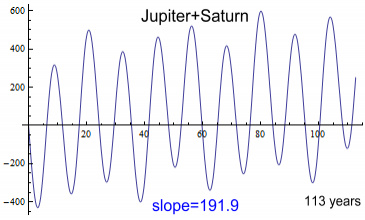
The chart contains a main wobble from Jupiter and a lesser one from
Saturn. The slope of this chart is 192 arcs/cent.
Adding together the stand-alone contributions from Jupiter and Saturn
would predict 155+7= 162. So their combined contribution is
greater than their sum by 30 arcs.
Now to simulate the contributions of all planets from Venus to
Neptune. Here’s the result:
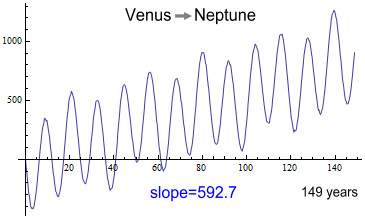
The chart is now very wobbly as it contains contributions from seven
planets, although most are too small to see.
The overall slope is 593 arcs/cent. Whereas the sum of their
individual contributions was 552 arcs/cent.
That’s an increase of 41 arcs and the result is now larger than the
observed 575 number. This also shows the ring-planet model is
rather busted, and yet there is still more to consider.
Motion of the Sun
When modelling the solar system it is common practice to consider the
Sun fixed at a central point while the other planets orbit
it. But in reality the Sun moves about quite a bit, due
mainly the influence of Jupiter and Saturn. This diagram
shows a sample of its motion:

Motion of the Sun around the Solar System Barycenter.
(source: orbitsimulator.com)
The Sun will often move outside of its average location by over a full
radius. For some reason this never appears to be considered
when modelling Mercury’s perihelion motion. Table 1 mentions
the influence from the Sun’s oblateness, which is the bulge at its
equator. This oblateness is a mere one part in a hundred
thousand and is considered in Mercury’s motion. Whereas a
movement over 100,000 times the bulge is completely ignored!
Given the complexity of motion, the fact that it was ignored is
understandable, but certainly not excusable. It would have
been better for the earlier researchers to admit that the problem was
unsolvable rather than claim to have a definitive answer (and end up
misleading everyone).
So how then would the Sun’s motion affect Mercury? To answer
this we will return to the simple simulation of the ‘sun/venus/mercury’
system but this time allow the sun to move freely.
Allowing the sun to move means that venus will be instead orbiting a
barycentre, which will be the centre of mass for this system. This
will require giving venus a slight boost in velocity in order for it to
have a circular orbit. Doing this results in this perihelion
advance:
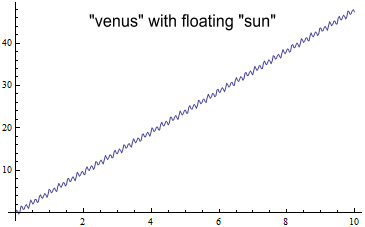
The first thing that stands out is that allowing the sun to move freely
results in much less wobble for the overall orbit and
perihelion. Actually the orbit is wobbling quite a bit when
viewed relative to the system’s barycentre. What is shown
here is the motion of mercury relative to the sun, because that is how
the real Mercury’s orbit is measured.
The slope of this line is 4.78deg/min. This is larger than
the 4.28deg/min when the sun was fixed. If we give
venus the same starting velocity as before (when the sun was fixed),
its orbit will be slightly elliptical rather than circular, and
mercury’s perihelion slope will be 5.68deg/min.
What this shows is that there is a distinct difference between having
the Sun fixed vs. free-floating.
We’ll now apply the same simulation to the actual planets.
The starting velocity of each outer planet will be given a slight boost
in order to make its orbit period match the observed. Here
are the charts:
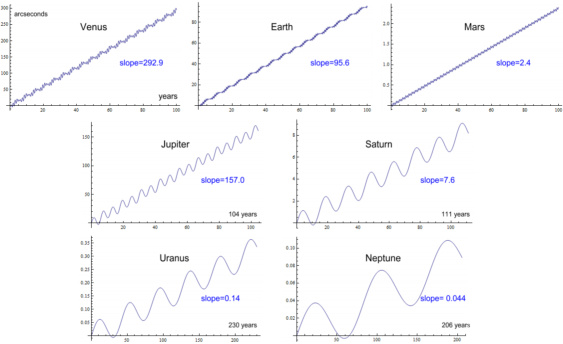
(click to enlarge)
| Planet |
arcs/cent |
| Venus |
292.9 |
| Earth |
95.9 |
| Mars |
2.4 |
| Jupiter |
157.0 |
| Saturn |
7.6 |
| Uranus |
0.14 |
| Neptune |
0.04 |
| Total |
556.0 |
|
Table 5: contributions from a floating Sun |
Comparing this with Table 4, the perihelion advances have decreased for
the inner planets and increased for the outer planets. The
overall total is 556 – an additional 2 arcs.
So the effects of a floating Sun turns out to be not much different
from the fixed Sun situation, but still substantially more than the
effects of oblateness (0.0254arcs), meaning that the motion of the Sun
shouldn’t be ignored.
Eccentric Orbits
Up until now the planets surrounding Mercury have been modelled as
having circular orbits. In reality their orbits are slightly
elliptic or ‘eccentric’. So we need to redo the above using
the proper orbit shapes. Doing so gives these charts:

(click to enlarge)
| Planet |
arcs/cent |
| Venus |
285.1 |
| Earth |
91.7 |
| Mars |
2.0 |
| Jupiter |
153.8 |
| Saturn |
7.5 |
| Uranus |
0.14 |
| Neptune |
0.04 |
| Total |
540.3 |
|
Table 6: contributions from eccentric orbits and a floating Sun |
Comparing this to Table 5 shows the effects have been reduced and the
total is 16 arcs less at 540 arcs/cent.
The next step is to combine these eccentric orbits so that they are
happening simultaneously. Doing so gives:

The result is 547 arcs/cent – 6 more than when the effects were applied
separately.
Putting it All Together
There is a final important aspect to consider, and that is the fact
that the planets don’t orbit in the same plane. Instead, each
planet, including Mercury, is a tilted ellipse, and their perihelions
don’t line up either.
To find out what the effect of all this is will require a full
three-dimensional simulation of the Solar System, with each of the
planets’ orbits set at their proper inclination, tilt and
rotation. Doing this over a period of 200 years gives the
result:
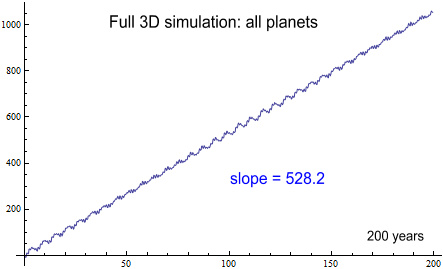
(Fig. 20 - click to enlarge)
The slope on this is 528.2 arcs/century. Comparing this with
Table 1 shows that this is 3.4 arcs less than the 531.6 arcs calculated
using the ring-planet model.
Adding in 0.025 arcs for solar oblateness brings this simulated number
up to 528.25 arcs. This means the discrepancy between the
observed and simulated calculated is 45.85 arcs, which is 2.9 arcs or
6.7% higher than the General Relativity prediction of 42.98 arcs.
Is this 3 arcseconds discrepancy a problem? According to
Table 1, the error in the observed value has an error of +/-0.65, so 3
arcs is well outside the maximum error. The above chart (Fig.
20) was simulated with an accuracy of 10cm over 200years and so should
be quite reliable.
We can redo the simulation using the aphelion as the starting point for
the outside planets, with mercury still starting at its
perihelion. Doing so gives a very similar result of 528.3 –
see chart here.
This shows that the starting location of the
outside planets is not important to the long-range average.
Using HORIZONS Data
There is another source of data we can use to get starting positions
and velocities for all the planets and the Sun: JPL’s HORIZONS system
[6]. It can give us the position and velocity of all the
planets the Sun for a requested date and time, relative to the Solar
System Barycentre.
The starting time will be chosen as February 1st 2001 at 15:14, because
this corresponds to a perihelion point of Mercury. With these
starting conditions, running a simulation over a hundred year period
gives this result:

(click to enlarge)
The slope on this is 531.7 arcs/century. This is now almost
identical to the ‘official’ amount of 531.63 arcs/century.
What has happened? Why does this not agree with the above
simulation showing 528.2 arcs?
A casual look at the end positions of the planets shows Earth to be in
a very different location than where it started – 22 degrees further
ahead. After 100 years, or any integer multiple number of
years, Earth should be at the same place as where it started.
Looking at the other planets and comparing their simulated location to
where HORIZONS says they should be located 100 years later (February
2nd 2101 at 15:14), shows they are also far removed from where they
should be. How could that be when the simulation accuracy was
set so high as to be only out by 10cm?
Further investigation revealed this was because the simulated orbit
periods were too short. Earth should have an orbital period
of 365.26 days, but the simulation showed 365.03 days. Over a
hundred year period Earth thus lost 23 days and ended up 22 degrees
further ahead in its orbit.
Similar problems were evident with all the planets – all except Neptune
had too short an orbit period. This table reveals the extent
of the problem:
| Planet |
period
(should be) |
period
(calc) |
error % |
degree error
after 100 yrs |
| Mercury |
87.97 |
87.908 |
-0.07 |
105.4 |
| Venus |
224.7 |
224.587 |
-0.05 |
29.4 |
| Earth |
365.26 |
365.031 |
-0.06 |
22.6 |
| Mars |
686.98 |
686.66 |
-0.04 |
8.9 |
| Jupiter |
4332.82 |
4329.86 |
-0.06 |
2.1 |
| Saturn |
10755.7 |
10747.44 |
-0.07 |
0.9 |
| Uranus |
30687.2 |
30668.05 |
-0.06 |
0.3 |
| Neptune |
60190.0 |
60198.08 |
+0.01 |
-0.03 |
|
Table 7: errors in orbital periods from HORIZONS data |
The majority of planets have an orbit period around 0.06% less than
they should have. For the inner planets this leads them being
in completely the wrong location. Mercury is ahead by 105
degrees!
By comparison the simulation used on Fig. 20 was out by 6.3 degrees for
Mercury and 0.5 degrees for Earth (over a 100 year period).
Looking further into the cause of this reveals that HORIZONS is giving
us the correct positions but wrong velocities of the planets.
The velocities are being understated and this results in planets
orbiting closer to the Sun with shorter periods.
For example at Mercury’s perihelion, to get a period of 87.97 days, the
tangential velocity needs to be 58,987m/s. Instead it is
58,977m/s – 10m/s less – and this results in a period of 87.908
days. For Earth, the velocity at perihelion needs to be
30,292m/s. But HORIZONS (at 2001-01-04 08:53) says it is
30,282m/s, giving a period of 364.90 days.
So the velocities are wrong, and they lead to orbits closer to Mercury
and a larger perihelion advance. Given that this advance is
almost identical to the amount required by GR, there’s a strong
possibility that the velocities have been deliberately tampered with in
order to confirm the predictions of GR.
Conclusion
Early analysis of Mercury’s motion was based on simplified models that
ignored aspects such as the outer planets’ speeds, their combined
contributions, and the motion of the Sun. This led to the
conclusion that Newtonian gravity would predict Mercury to precess by
532 arcseconds per century, and that there exists a discrepancy of 43
arcs/cent that can be attributed to General Relativity.
A proper analysis that considers all aspects of Solar System motion
however shows the Newtonian prediction to be 528 arcs/cent, making the
discrepancy 46 arcs/cent, and this is not in agreement with GR.
[1]
https://en.wikipedia.org/wiki/Tests_of_general_relativity
[2]
http://articles.adsabs.harvard.edu//full/1859AnPar...5....1L/0000008.000.html
To read in PDF form, click on the ‘Print this article’ (top right),
click on the ‘YES’, and that will open/save as a single PDF.
[3]
http://journals.aps.org/rmp/abstract/10.1103/RevModPhys.19.361
A backup copy is here.
[4]
http://www.jstor.org/stable/10.2307/1005431
[5]
http://www.math.toronto.edu/~colliand/426_03/Papers03/C_Pollock.pdf
[6]
http://ssd.jpl.nasa.gov/?horizons
Select ‘Web Interface’, then apply these settings:
Ephemeris Type:
VECTORS
Target Body: Mercury
[199]
Coordinate Origin:
Solar System Barycenter (SSB) [500@0]
Time Span:
Start=2001-02-01 15:14, Stop=2001-02-01 15:15, Step=1 m
Table Settings:
output units=KM-S; quantities code=2
Display/Output:
default (formatted HTML)
Then click ‘Generate Ephemeris’. The
starting position/velocity of Mercury will be the X/Y/Z and VX/VY/VZ of
the first entry (15:14:00), multiplying by 1000 to convert to
metres. Then repeat this for each of the planets, including
the Sun, by changing the ‘Target Body’.
|




















